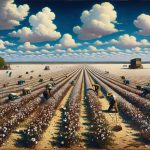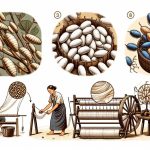Do you ever wonder who the top global producers of fabric are? In this article, we’ll take a closer look at the countries leading the way in fabric production.
China, India, the United States, Germany, and Japan are all major players in this industry. From China’s powerhouse status to Germany’s focus on quality and precision, each country brings its own unique contributions.
So, let’s dive in and explore the world of fabric production together!
Table of Contents
China: The Fabric Production Powerhouse
When it comes to fabric production, China reigns as the powerhouse among global producers. Chinese factories have embraced automation, revolutionizing the industry and increasing efficiency. With advanced machinery and technology, these factories have significantly reduced labor costs while increasing productivity. Automation hasn’t only improved the speed and accuracy of fabric production but has also allowed for better quality control, ensuring consistent results.
However, the environmental impact of fabric production in China is a major concern. The rapid growth of the industry has led to significant pollution and resource depletion. The use of chemicals and water in the dyeing and finishing processes has resulted in water pollution and contamination. Additionally, the high energy consumption of the factories contributes to carbon emissions and air pollution.
To tackle these issues, the Chinese government has implemented stricter regulations and encouraged the adoption of greener practices. Many factories are now investing in eco-friendly technologies and processes, such as water recycling and energy-efficient machinery. Furthermore, there’s a growing trend towards sustainable and organic fabrics, which are produced using environmentally friendly methods.
While China remains the leader in fabric production, it’s crucial for the industry to continue striving towards sustainability and minimizing its environmental impact. By embracing automation and implementing eco-friendly practices, Chinese factories can contribute to a greener and more sustainable future for the global fabric industry.
India: A Textile Giant on the Rise
As we shift our focus to the rising textile giant, India, let’s delve into its increasing prowess in fabric production. India has been experiencing significant textile growth in recent years, solidifying its position as one of the top global producers of fabric. The country’s textile industry has seen remarkable expansion, driven by advancements in technology, infrastructure, and skilled labor.
One area where India stands out is in its commitment to sustainability in fabric production. With growing concerns about the environmental impact of the textile industry, Indian manufacturers have taken proactive measures to adopt eco-friendly practices. They’re investing in sustainable manufacturing processes, utilizing organic and natural fibers, and implementing water and energy-saving techniques. This focus on sustainability not only benefits the environment but also enhances the reputation of Indian textiles in the global market.
Furthermore, India’s diverse range of textiles caters to both domestic and international demands. The country produces a wide variety of fabrics, including cotton, silk, wool, and synthetic fibers. This versatility allows India to cater to different consumer preferences and market segments, making it a preferred sourcing destination for many global brands.
United States: Innovating the Fabric Industry
Now let’s explore how the United States is revolutionizing the fabric industry with its innovative approaches.
The United States is leading the way in sustainable fabric practices, implementing environmentally friendly methods to reduce the industry’s impact on the planet. Companies are increasingly focused on using recycled materials, organic fibers, and natural dyes to create fabrics that are both stylish and sustainable. These sustainable fabric practices not only benefit the environment but also cater to the growing demand for eco-friendly products from conscious consumers.
Another significant innovation in the fabric industry is the impact of automation in fabric production. With advancements in technology, automated machines are now being used to streamline and improve the efficiency of fabric manufacturing processes. This has led to increased production capacity, reduced labor costs, and improved product quality. Automation has also allowed manufacturers to meet the demands of a rapidly evolving market by producing fabrics at a faster pace.
Germany: Quality and Precision in Fabric Production
Germany continues the tradition of excellence in fabric production, building on the innovative approaches of sustainable practices and automation implemented by the United States. The German approach to fabric production can be distinguished by its focus on quality rather than quantity.
Here are four key aspects that highlight Germany’s commitment to producing high-quality fabrics:
-
Craftsmanship: German fabric producers prioritize meticulous attention to detail and precision in every stage of the production process. This emphasis on craftsmanship ensures that each fabric is of the highest standard.
-
Innovation: Germany is known for its continuous pursuit of innovation in fabric production. From developing advanced weaving techniques to experimenting with new materials, German fabric manufacturers are at the forefront of technological advancements in the industry.
-
Sustainable Practices: Environmental consciousness is deeply ingrained in the German fabric production industry. Producers prioritize sustainable practices, such as using eco-friendly dyes and minimizing waste, to reduce their ecological footprint.
-
Durability: German fabrics are renowned for their durability. Manufacturers in Germany prioritize creating fabrics that are long-lasting and can withstand wear and tear, ensuring that customers receive products of exceptional quality.
Through its focus on craftsmanship, innovation, sustainability, and durability, Germany has had a significant impact on the global fabric market. Its fabrics are sought after by discerning customers who value quality and precision.
Japan: Combining Tradition and Technology in Textiles
Japan’s textile industry combines traditional craftsmanship with cutting-edge technology, creating a unique blend of heritage and innovation. When it comes to textile production, Japan leads the way in combining the best of both worlds.
With a rich history of textile manufacturing techniques passed down through generations, Japan has managed to preserve its traditional heritage while embracing modern advancements.
One of the key factors that sets Japan apart is its commitment to quality and attention to detail. Japanese textile manufacturers take great pride in their meticulous craftsmanship, ensuring that every piece of fabric produced meets the highest standards. This dedication to excellence has earned Japan a reputation for producing fabrics of exceptional quality.
At the same time, Japan has always been at the forefront of technological innovation. The country constantly invests in research and development to enhance their textile production processes. From advanced weaving and dyeing techniques to the use of state-of-the-art machinery, Japanese textile manufacturers utilize cutting-edge technology to improve efficiency and create innovative fabrics.
This combination of heritage and innovation has propelled Japan to the top of the global textile production industry. Japanese textiles are sought after worldwide for their superior quality, intricate designs, and durability. From traditional kimono fabrics to high-tech performance textiles, Japan continues to lead the way in producing fabrics that seamlessly blend tradition with modernity.
Frequently Asked Questions
How Does the Fabric Production in China Compare to Other Countries in Terms of Quantity and Market Share?
In terms of quantity and market share, China is the leading producer of fabric. Its fabric production surpasses that of other countries, securing a dominant position in the global market.
What Are the Main Challenges Faced by India in Becoming a Major Player in the Global Fabric Production Industry?
In becoming a major player in the global fabric production industry, India faces challenges. These include competing with China in terms of quantity and market share, as discussed in the previous question.
How Has the United States Contributed to the Innovation and Technological Advancements in Fabric Production?
The United States has played a major role in fabric innovation and technological advancements. Their involvement has led to significant progress in fabric production, making them a key player in the industry.
What Are Some Unique Characteristics of German Fabric Production That Set It Apart From Other Countries?
When it comes to German fabric production, one unique characteristic that sets it apart is its focus on sustainability. German fabric producers prioritize environmentally friendly practices, making them leaders in sustainable fabric production.
How Has Japan Managed to Combine Traditional Textile Techniques With Modern Technology in Its Fabric Production?
In Japan, traditional techniques and modern technology have been skillfully combined in fabric production. This innovation has resulted in a unique blend of craftsmanship and efficiency that sets Japan apart in the global market.





